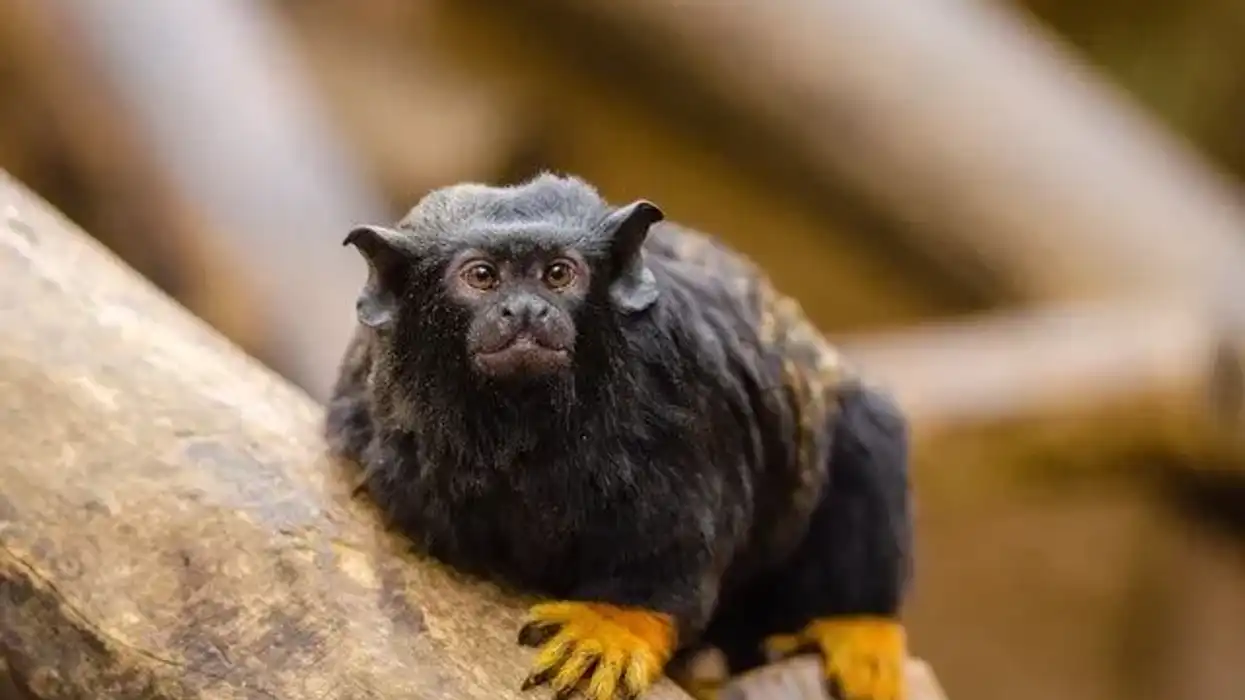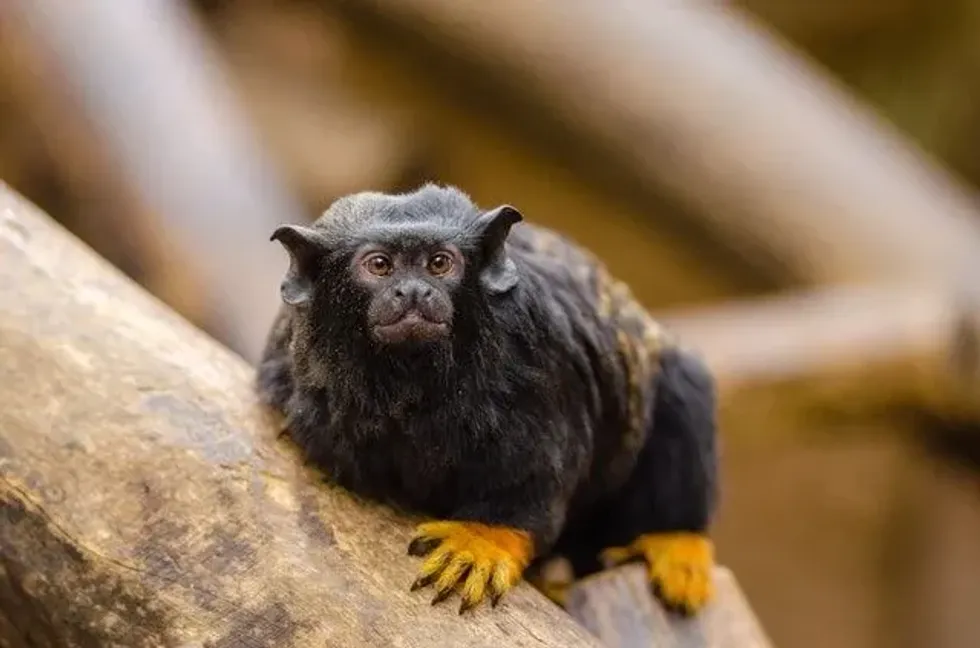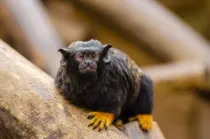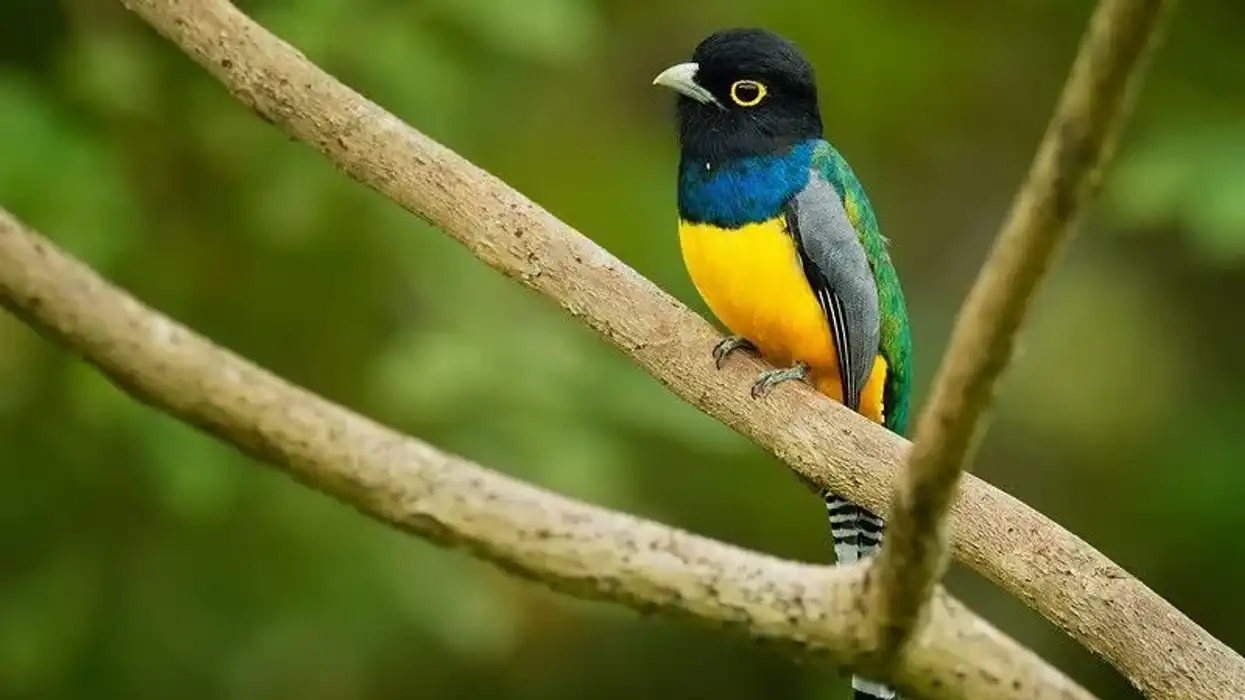Fun Red-handed Tamarin Facts For Kids

The red-handed tamarin is also called the Midas tamarin or the golden-handed tamarin because of the bright colors of its feet and hands. The red-handed Tamarin taxonomy is inspired by King Midas, the Greek mythological figure who is believed to have turned whatever he touched into pure gold.
This is a primate species that typically occupies lowland tropical forest regions in South America (Brazil, Guyana, French Guiana, Suriname, and Venezuela (possibly)). They occupy areas north of the Amazon river in these regions.
Red-handed tamarins are part of a distinct primate group, referred to as the New World monkeys. Other members of this group include Goeldi’s monkeys, lion tamarins, and marmosets. The group of New World monkeys is found exclusively in America.
Red-handed tamarins have a stout body, flat snout, a hairless face, and ears that stick out from either side of their head. Their fur is usually black or dark brown, with reddish-orange hair on their hands and feet.
Their non-opposable thumbs make it difficult for them to grip objects and they have claws on their hands and feet, except for the big toe. The IUCN Red List has given this tamarin species the conservation status of Least Concern.
Read on for more facts about these animals. For other interesting facts about animals, check out our articles on the aye-aye and siamang.
Red-handed Tamarin Interesting Facts
What type of animal is a red-handed tamarin?
The red-handed tamarin belongs to the group of New World monkeys found in America. The scientific name for members of this species of monkeys is Saguinus midas.
What class of animal does a red-handed tamarin belong to?
Red-handed tamarins are members of the class Mammalia, order primates, family Callitrichidae, and genus Saguinus. These New World monkeys are of the phylum Chordata.
How many red-handed tamarins are there in the world?
There are over 30 species of tamarin monkeys in the world, however, accurate estimates of the exact number of red-handed tamarins aren't available. Members of this species seem to be in good health and present in stable numbers, which is why the IUCN Red List has given these animals the conservation status of Least Concern.
Where does a red-handed tamarin live?
Red-handed tamarins live in lowland tropical forests in South America (Brazil, Guyana, French Guiana, Suriname, and possibly Venezuela). Their distribution typically spans wooded regions north of the Amazon river. Animals of this species usually prefer trees that have small crowns.
What is a red-handed tamarin's habitat?
The red-handed tamarin, Saguinus midas, is well adapted for a tree-bound or arboreal lifestyle in its natural habitat. Members of this species typically reside 45-55 ft above the ground.
Groups of this species live where the crown of trees can offer them protection, opportunities for socialization, as well as foraging opportunities. Just one group of this animal species can occupy a territory spanning approximately 25 full acres.
Who do red-handed tamarins live with?
Animals of this species live in groups of about 4-15 monkeys, although the average number is usually between six and eight animals. The group or troop generally has one dominant female animal, several breeding males, offspring, and subordinate animals.
A special breeding status is given to the dominant red-handed tamarin female animal in the group. The dominant female can release pheromones to suppress the abilities of other females to reproduce.
This gives her exclusive breeding rights with the males in the group.
Apart from the female responsible for reproduction within the group, there are adult helpers and non-breeding adults who help to raise the offspring before breeding when their time comes. Sometimes, small red-handed tamarin groups will merge in the wild to create larger groups.
How long does a red-handed tamarin live?
The average lifespan of the golden-handed tamarin is between 8-15 years.
The lifespan of this species of monkeys does differ on the basis of whether they live in the wild or are raised in captivity, with the golden-handed tamarin usually living longer when raised in captivity.
Some members of this tamarin species have even gone on to live for up to 20 years in captivity. This difference in lifespan when they live in the wild and when they are raised in captivity could be the result of predators and other threats to their population in the wild.
Conservation efforts are focused on increasing the numbers of this primate, so it is not surprising that those raised in captivity have a longer lifespan.
How do they reproduce?
The breeding season is between April and July in this species. Golden-handed tamarins are polyandrous, meaning that only one female is in charge of reproduction and will mate with several males during the breeding season.
The dominant female chooses the males she will breed with for reproduction. Males in the group must win her trust if they want to win the right to mate with her. The dominant female usually organizes reproductive activities in the breeding season so that competition among the males is reduced.
The gestation period for this species population lasts for a minimum of 140 days, after which, the female will give birth to one or two children in the spring or summer months.
The baby is nursed for the first two or three months by the mother while fathers usually carry the offspring on their back for the majority of the time.
Other females and males within the group take an active interest in caring for the offspring.
Offspring usually pick up foraging skills and forms of communication from others in the group. Full sexual maturity is achieved in this species following 16-20 months of age.
What is their conservation status?
According to the International Union for Conservation of Nature Red List of Threatened Species, the conservation status of this species is that of Least Concern. While males and females of this phylum aren't endangered yet, they do face some threats due to human activity.
Agricultural activities and logging have resulted in habitat destruction, reducing the amount of natural arboreal territory that the golden-handed tamarin has access to.
They are also hunted for meat or caught to sell on the exotic pet trade. Several protected areas in their habitat range are aimed at the conservation of this species.
Red-handed Tamarin Fun Facts
What do red-handed tamarins look like?
The red-handed tamarin has a stout body, flat snout, a face without hair, and ears that stick out from either side of the head.
The fur is usually black or dark brown, with reddish-orange hair on the hands and feet. Their non-opposable thumbs make it difficult for them to grip objects and they have claws on their hands and feet, except for on the big toe.
They also have scent glands around the genitalia and mid-chest region which they use to mark their territory as well as communicate details about status, identity, and sexual receptivity.
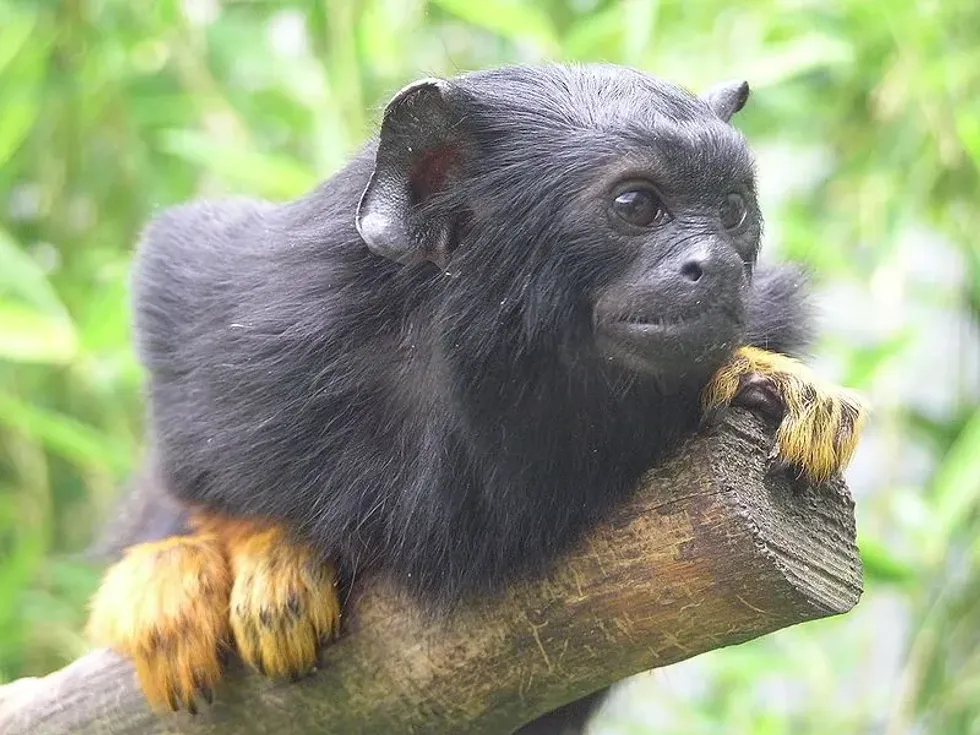
How cute are they?
Being about the same size as a squirrel, the red-handed tamarin is extremely cute.
How do they communicate?
The behavior of this species is guided by their communication which takes place mainly through vocalizations. Males and females of a group communicate their intention and mood through different vocalizations. Their long calls are territorial calls, their alarm calls consist of chirps, and their trills are agonistic calls.
The scent glands around the genitals and in the mid-chest region are also used to mark territory and communicate details about identity, status, and sexual receptivity in the red-handed tamarin species. They have a restricted range of facial features so facial expressions aren't very important when it comes to their communication.
If any tamarin is attacked or threatened, others usually rush as a group to help. They can lunge out using their claws and sharp teeth.
How big is a red-handed tamarin?
There is a small difference in size between a male and female red-handed tamarin. While their bodies are generally 8.1–11 in (20.5–28 cm) long from head to rump; another 12–17 in (31–44 cm) includes the tail.
How fast can a red-handed tamarin run?
A golden-handed tamarin can travel at a top speed of 24 mph.
How much does a red-handed tamarin weigh?
This animal weighs 0.9–1.2 lb (400–550 g) on average. The red-handed tamarin skeleton resembles that of a squirrel. Offspring usually weigh 45 g at birth.
What are their male and female names of the species?
Males and females of this species aren't known by different names. They are just called red-handed tamarins or golden-handed tamarins.
What would you call a baby red-handed tamarin?
A red-handed tamarin baby is called an infant.
What do they eat?
The major portion of their diet consists of fruits from different plants. Their diet changes based on seasonal availability. The diet of the tamarin also consists of seeds, gum, nectar, and sap.
Being omnivorous, the red-handed tamarin eats insects, bird eggs, spiders, snails, and small frogs. They kill their prey with a single bite to the head before eating. Being a diurnal animal, the red-handed tamarin forages and socializes during the day and spends the night sleeping in trees.
Are they aggressive?
The red-handed tamarin temperament is generally a peaceful one. They are cooperative and good-natured animals that rarely get aggressive. They can, however, become quite aggressive when a member of the group is being attacked or when they need to defend their territory.
They show strength in numbers. If any tamarin is attacked or threatened, the others will rush in a group to help. They can lunge out using their claws and sharp teeth.
Would they make a good pet?
You can own a cotton top tamarin, red-handed tamarin, or some other species of tamarin, although it is not advisable especially for first-time pet parents. A red-handed tamarin can cost you $3,500 while a cotton top tamarin can cost $3,800.
While tamarins are friendly, active, and intelligent, they do require a lot more commitment and effort when compared to other pets. A red-handed tamarin pet will need a proper enclosure, training, and diet to lead a healthy life.
If you can't put in the time for them, they are not the pet for you. Keeping them as pets also brings up concerns about supporting the exotic pet trade.
Did you know...
Red-handed tamarins are crucial to the growth of the forest because of the role that they play in seed dispersal, from what they eat in their diet.
Natural predators of these animals include eagles, jaguars, snakes, and pumas.
These animals don't sleep in the same place for any longer than three consecutive days. They do, however, re-use sleeping sites that they haven't used for a while.
How far can a red-handed tamarin jump without getting injured?
The red-handed tamarin is extremely agile and an exceptional climber, spending most of its time among the branches of trees. It can jump great distances and has been known to jump distances of more than 18 m (60 ft) from tree to ground without showing any sign of injury.
What will a group of red-handed tamarins do if one of them is attacked?
If a member of the group is attacked or threatened, other group members come to its aid. They usually lunge out in groups and can be vicious with their sharp teeth and claws.
Here at Kidadl, we have carefully created lots of interesting family-friendly animal facts for everyone to discover! Learn more about some other mammals including the coquerel's sifaka, or emperor tamarin.
You can even occupy yourself at home by drawing one on our Red-handed Tamarin tamarin coloring pages.
We Want Your Photos!
More for You
See All
Bachelor of Science specializing in Human Anatomy

Joan AgieBachelor of Science specializing in Human Anatomy
With 3+ years of research and content writing experience across several niches, especially on education, technology, and business topics. Joan holds a Bachelor’s degree in Human Anatomy from the Federal University of Technology, Akure, Nigeria, and has worked as a researcher and writer for organizations across Nigeria, the US, the UK, and Germany. Joan enjoys meditation, watching movies, and learning new languages in her free time.
Bachelor of Arts specializing in English Language and Literature, Master of Arts specializing in Philosophy and Religious Studies

Tehil DavidBachelor of Arts specializing in English Language and Literature, Master of Arts specializing in Philosophy and Religious Studies
Tehil David Singh is a fact checker with a Bachelor's degree in English literature from St.Xavier's College, Palayamkottai, and a Master's degree in Philosophy, and Religion from Madurai Kamaraj University. He has a passion for writing and hopes to become a story writer in the future. Tehil has previously interned in content writing and has been a content creator for the last three years. In his personal life, he enjoys singing, songwriting, performing, and writing stories.
Disclaimer
1) Kidadl is independent and to make our service free to you the reader we are supported by advertising. We hope you love our recommendations for products and services! What we suggest is selected independently by the Kidadl team. If you purchase using the Buy Now button we may earn a small commission. This does not influence our choices. Prices are correct and items are available at the time the article was published but we cannot guarantee that on the time of reading. Please note that Kidadl is a participant in the Amazon Services LLC Associates Program, an affiliate advertising program designed to provide a means for sites to earn advertising fees by advertising and linking to Amazon. We also link to other websites, but are not responsible for their content.
2) At Kidadl, we strive to recommend the very best activities and events. We will always aim to give you accurate information at the date of publication - however, information does change, so it’s important you do your own research, double-check and make the decision that is right for your family. We recognise that not all activities and ideas are appropriate for all children and families or in all circumstances. Our recommended activities are based on age but these are a guide. We recommend that these ideas are used as inspiration, that ideas are undertaken with appropriate adult supervision, and that each adult uses their own discretion and knowledge of their children to consider the safety and suitability. Kidadl cannot accept liability for the execution of these ideas, and parental supervision is advised at all times, as safety is paramount. Anyone using the information provided by Kidadl does so at their own risk and we can not accept liability if things go wrong.
3) Because we are an educational resource, we have quotes and facts about a range of historical and modern figures. We do not endorse the actions of or rhetoric of all the people included in these collections, but we think they are important for growing minds to learn about under the guidance of parents or guardians.
